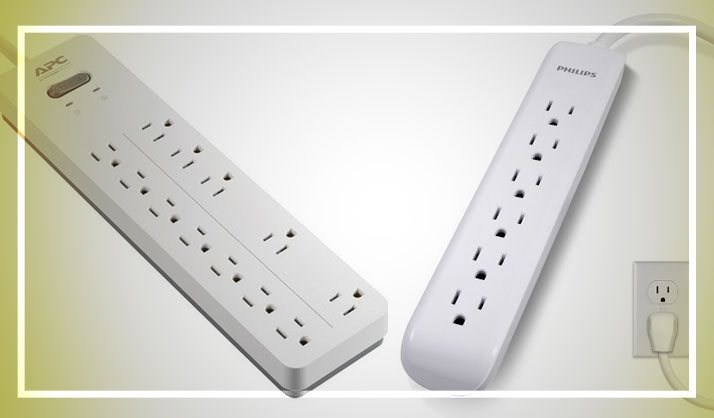The voltage surge is one of the most frequent and terrifying power problems at home. The sudden movement of the electricity due to the power or voltage surge causes damage to many expensive home appliances. Thus, you need to find a way to protect the home appliances from such inconvenient power problems.
In this regard, people use surge suppressors and surge protectors mostly. Although these devices look identical and share a few common features, they also have important distinctions. So, what are the differences between surge suppressor vs surge protector?
The surge suppressor will make it regular and constant when any power splurge occurs by controlling the voltage flow. On the contrary, the surge protector is, on the other hand, designed to avoid the rapid voltage spikes so that it remains constant.
So, let’s jump deep into the key differences between these two devices to know which one you should choose. It will help you realize which device to pick for the best protection of your home appliances.

What are Power Surge and its Consequences?
The power surge refers to a condition when the voltage in an electric circuit rises suddenly for a brief period. The sudden rise of the power surge may occur for 1-10 milliseconds. Also, its rating is more than 100 AMPs current and 2000V. In a nutshell, when the electric voltage in a circuit rises above 2000V and 100AMPs suddenly and then goes back to normal, it is called a surge.
The surge is also referred to as transient. Its main reasons are:
- Improper, defective, or damaged wiring
- When electric equipment fails
- Simultaneous operation of multiple high-voltage appliances
- Lightning strikes and electric outages
- Rapid electric noise
When power transient happens, it can be dangerous for electric appliances. Thus, you must know the consequences of it.
- Your electric devices will fail or get damaged. That’s why refrigerators, air conditioners, etc., become damaged frequently due to the power surge.
- If you work on the computer, you may lose the data and work progress.
- You will lose valuable time and business hours. So, it is avoidable for business.
Surge Suppressor VS. Surge Protector
You now know the causes and consequences of a power surge. Therefore, you would want to skip the consequences of it anyhow. And for this, the use of a surge protector or surge suppressor is preferable. However, you should know their differences to choose the right device.
Definition:
The surge protector will skip the voltage spikes. You can set the voltage rating at a sudden stage, and the device will allow the voltage to flow above the stage you have set.
On the other side, the surge suppressor goes one step above and controls the voltage flow. Also, when there’s a power splurge, it will ensure the consistency of the voltage. This way, the surge suppressors will protect the electrical equipment.
Differences in the working process:
Surge suppressors and surge protectors have different ways of working. They act differently when there’s a power splurge in the circuit.
The surge protector will skip the sudden rise or spikes of the voltage to protect the devices. The device will constantly measure the voltage flow. When it detects any irregular spikes, it will stop the power flow temporarily. As a result, the device itself dies.
On the contrary, the surge suppressor controls the voltage. When it detects any inconsistency in the voltage flow, the device will regulate the voltage. Consequently, it comes down to the regular stage. So, the device ensures that the voltage doesn’t rise above the recommended level.
Common uses:
Although both devices may look similar and even have identical functioning, they have different uses. You will see surge protectors in industries and large-scale power projects. Its common uses include the following ones.
- Computer data server and lines
- Telecommunication sector
- Communication lines
- In homes and offices with electrical connections
The surge suppressor also has broader applications. You will see its uses in the following sectors.
- Residential appliances and electric lines
- Commercial electric connections
Different Types Of Surge Suppressors And Surge Protectors
These two voltage controller devices are available in various types. These types of devices are required for applications in different places.
Common types of surge suppressors are:
- Avalanche Diode
- Gas tube
- Thyristor Diode
- MOV
MOV is the general and most commonly used type of surge suppressor. The gas tube is used for the systems with the high-voltage flow.
The most common types of surge protectors are:
- Transient diverters
- Filters
The filter is the basic system that will only allow low-flow current or voltage to pass through the device. As the name suggests, transient diverters will divert the high-voltage in the ground to protect the devices.
Conclusion
The basic difference between surge suppressor and surge protector is how they work. The protector skips the voltage spikes, and the suppressor regulates the voltage and ensures its consistency.
For residential uses, a surge suppressor is preferable. You can also use it in offices and commercial spaces. On the other side, you will see the use of surge protectors in industrial sectors.
I’m James. The author of Electricalaffairs.com. It’s been my passion to deal with power tools and gears. This website is mainly to talk about electrical wirings, lighting, various power source tools and accessories. I want to explore tackles and help people to grow their basic knowledge about electrical things. I would also like to help people to pick the right power tool for their daily needs.

can a surge protector be installed directly to the main wires without a breaker? can i install it to a transfer switch?
No, a surge protector cannot be installed directly to the main wires without a breaker. The breaker is necessary to provide safety and protection from electric shock, and it is required by the National Electrical Code (NEC).